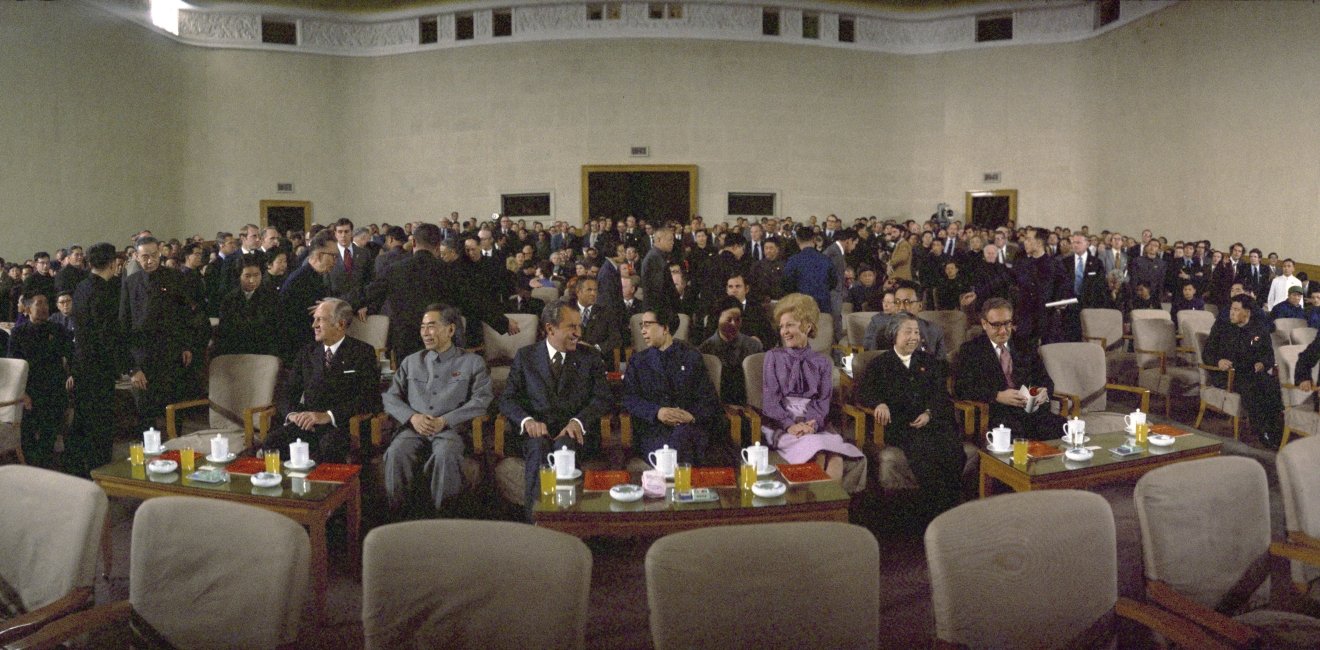Nixon’s 1972 Visit to China at 50
An overview of Richard Nixon’s February 1972 visit to China and associated Wilson Center publications and Digital Archive resources.

A blog of the History and Public Policy Program
An overview of Richard Nixon’s February 1972 visit to China and associated Wilson Center publications and Digital Archive resources.

On the morning of February 21, 1972, US President Richard Nixon landed in the People’s Republic of China.
The visit was a visual spectacle for the US President, his entourage, and much of the rest of the world, which closely watched the American leader’s travels inside the world's largest communist country.
A whirlwind tour through three of China’s major cities brought Nixon to several famed historical sites and cultural performances (including a revolutionary ballet), and face-to-face with many senior Chinese leaders. Photographs of Nixon standing on top the Great Wall, viewing The Red Detachment of Women, or toasting Chinese Premier Zhou Enlai circulated widely around the globe. So too did photos of first lady Pat Nixon inspecting a kitchen at a Beijing hotel.
Nixon’s visit was not only symbolic; it was also substantive. It was a stunning development in international politics, one that has often been hailed as a “week that changed the world.”
Nixon was the first American president to ever visit mainland China while in office, a now almost routine act undertaken by US heads of state. The visit helped to break several decades of US-PRC hostility and launched a new cooperative course in the relationship that generally persisted until the end of the Cold War, if not longer. The US-China rapprochement, symbolized by Nixon’s visit, substantially altered the international balance of power and arguably concluded the Cold War in East Asia.
Although Nixon met with Chairman Mao Zedong only once during the visit, the two had a meaningful dialogue on “philosophic problems” in the US-China relationship. They also shook hands with each other, the photograph of which is probably the most famous image to come out of the trip.
Premier Zhou chaperoned Nixon for most of the trip, having been delegated responsibility for the fine grain details of US-China relations by Chairman Mao. Aside from wining and dining, the two sat down several times to exchange views on a host of international problems – from the Vietnam War to the Soviet Union to the status of Taiwan. Before the US president left China, the Nixon and Zhou teams hammered out an agreement between the United States and China known as the Shanghai Communique – a document that outlined both individual and common interests, articulated a “One-China” policy that would redefine cross-strait and US-Taiwan relations, and called upon both countries to work together toward diplomatic normalization.
A pivotal moment in twentieth century diplomatic history, historians and other observers nevertheless continue to debate the visit, its legacies, and some of the myths that have come to surround it. They ask whether it really was “the week that changed the world”, and they question whether Nixon, a Republican and staunch anti-communist, was really the only American leader capable of opening relations with China. They also highlight that Nixon was perhaps a follower, not a trendsetter, among democratic countries in seeking a new modus vivendi with China.
Equally important, historians of China have flipped the script. Rather than seeking to answer why Nixon went to China, they instead focus on what the Chinese Communist Party wanted when it allowed Nixon to come to China. Many scholars have also emphasized that the Nixon visit, despites its immense international ramifications, did not change US-China relations overnight. A still rather tedious negotiating and acculturation process was necessary before the formal exchange of diplomatic relations could be achieved in 1979, and before business, military, cultural, and people-to-people ties could flourish over the next few decades.
And of course, fifty years after the fact, the Nixon visit is now being evaluated in an entirely new and “revisionist” light, given the precarious state of US-China relations today.
The Wilson Center’s Digital Archive contains a considerable number of documents surrounding the Nixon visit to China.
Key materials from February 1972 include the verbatim records and agreements of US-China bilateral exchanges, including:
Although declassified Chinese language records from the February 1972 are generally lacking (the Chinese Foreign Ministry Archives never released any materials dated later than 1966), the Digital Archive does feature a number of sources from before and after the visit. In one Chinese record from December 1970, Mao Zedong confided to Edgar Snow that he liked Nixon's "reactionary" approach to foreign policy and desired to speak with him directly. A 1975 evaluation from senior leader Geng Biao, in contrast, said that “Nixon visited China because his policy of isolating China had become bankrupt” and that China had “allowed Nixon’s visit, not in the slightest due to positive feelings toward the US.”
The Digital Archive also contains the record of a talk between Zhou Enlai and the U.S. table tennis team, an important stepping stone to the Nixon visit.
The Digital Archive also features materials on the diverse responses to Nixon’s visit from members of both the capitalist, communist, and non-aligned camps. A memorable protest from Enver Hoxha of Albania, for example, asked Mao Zedong to reconsider his plan to host the US President. “Nixon’s announced visit to China will not be understood and approved by the people, the revolutionaries, and the communists of different countries,” Hoxha wrote.
Two Digital Archive collections follow the trajectory Sino-American relations before and after the Nixon visit. The first, “Sino-American Confrontation, 1949-1971" provides insights into the contentious relationship from the founding of the PRC roughly up through National Security Advisor Henry Kissinger’s secret visit to China in 1971. The second collection, “Sino-American Cooperation, 1972-1989," details the new, cooperative phase in relations that followed Nixon’s visit in 1972 and lasted until the brutal crackdowns on China’s pro-democracy movement in 1989.
Pete Millwood - No, Not Only Nixon Could Go to China
Fifty years after the Nixon-Mao summit, it is time to put to rest the myth that Nixon alone could pursue rapprochement with China; other American politicians advocated engagement—and were even invited to China before Nixon.
On February 22, 1972, the People’s Daily printed a picture of Chairman Mao shaking hands with Richard Nixon. How could Mao pull off such a stunt after two decades of intense anti-US propaganda?
Federico Pachetti - “Nixon in China: The Week that Changed…What?”
If we scratch away the theatrics, “The Week that Changed the World” looks less momentous than many have portrayed it.
Chen Jian - “From Mao to Deng: China’s Changing Relations with the United States”
What is the meaning of China’s rise? What are its consequences? Are China, the rising power and the world’s second largest economy, and the United States, the dominant power in the world, likely to chart a perilous course toward the “Thucydides’s Trap”? History alone does not provide direct answers to these critical questions. Yet, reflections on the history of Chinese-American relations in the 20th-century—and the past four decades in particular—may offer some time-tested wisdom, thus letting us occupy a more informed and discerning position to deal with vital challenges facing both the United States and China.
Zhou Yi - “Less Revolution, More Realpolitik: China’s Foreign Policy in the Early and Middle 1970s”
Zhou Yi analyzes a speech made by a senior Chinese official at an unexpected venue - a tourism conference - in March 1975 to decode broad shifts in Chinese foreign policy at the end of the Mao era.
Examining China's perceptions and tactics in negotiating with the United States during the Cold War, this Working Paper features an introduction by Yafeng Xia and translations of more than 30 original documents from the Chinese Foreign Ministry. It adds textures and nuance to our understanding of China's mindset and strategies in diplomatic negotiations, and should aid American diplomats dealing with China in the 21st Century.
What Lessons Can We Learn from “The Week that Changed the World?”
For the 50th anniversary of the "week that changed the world"--- the summit between the United States and China from February 21-28, 1972 during which US President Richard Nixon met with Chinese Communist Party leader Mao Zedong--- this video features excerpts from China experts on the significance of what is considered one of the major diplomatic turning points in modern history.
dialogue: President Nixon Visits China: The Week That Changed the World
J. Stapleton Roy, Douglas Spelman, and Yafeng Xia revisit a critical turning point in the history of the Cold War, President Nixon’s visit to China in 1972, on an episode of the Wilson Center's dialogue.


A leader in making key foreign policy records accessible and fostering informed scholarship, analysis, and discussion on international affairs, past and present. Read more


The Cold War International History Project supports the full and prompt release of historical materials by governments on all sides of the Cold War. Read more



